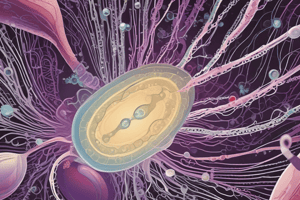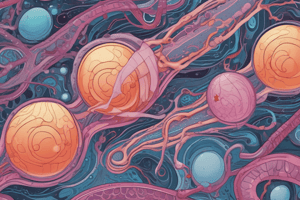Podcast
Questions and Answers
Where does sperm production occur in the testicles?
Where does sperm production occur in the testicles?
- Seminiferous tubules (correct)
- Interstitial cells
- Lining of the scrotum
- Tunica albuginea
What is the function of Leydig cells in the testicles?
What is the function of Leydig cells in the testicles?
- Producing sperm
- Creating the mediastinum testis
- Secreting testosterone (correct)
- Forming the tunica albuginea
How many pyramidal compartments or testicular lobules divide the testis?
How many pyramidal compartments or testicular lobules divide the testis?
- 50
- 500
- 250 (correct)
- 100
What is the main function of the tunica albuginea surrounding the testis?
What is the main function of the tunica albuginea surrounding the testis?
Where do the testes develop embryonically before moving to the scrotal sac?
Where do the testes develop embryonically before moving to the scrotal sac?
What is the first part of sperm production that involves mainly mitosis and meiosis?
What is the first part of sperm production that involves mainly mitosis and meiosis?
Which type of spermatogonia acts as stem cells, dividing infrequently and giving rise to more rapidly dividing cells?
Which type of spermatogonia acts as stem cells, dividing infrequently and giving rise to more rapidly dividing cells?
What are the cells with partially condensed chromosomes in various stages of synapsis and recombination during the first meiotic prophase known as?
What are the cells with partially condensed chromosomes in various stages of synapsis and recombination during the first meiotic prophase known as?
Which phase of meiosis involves homologous chromosomes separating and producing secondary spermatocytes?
Which phase of meiosis involves homologous chromosomes separating and producing secondary spermatocytes?
What is the result of the second meiotic division in spermatogenesis?
What is the result of the second meiotic division in spermatogenesis?
What allows free cytoplasmic communication among male germ cells during mitotic and meiotic divisions?
What allows free cytoplasmic communication among male germ cells during mitotic and meiotic divisions?
What is the function of the pampiniform venous plexus surrounding the testicular artery?
What is the function of the pampiniform venous plexus surrounding the testicular artery?
What triggers testosterone synthesis in interstitial cells?
What triggers testosterone synthesis in interstitial cells?
During which stage of development do fetal interstitial cells produce testosterone?
During which stage of development do fetal interstitial cells produce testosterone?
Where does sperm production mainly occur?
Where does sperm production mainly occur?
What type of cells physically and metabolically support developing sperm cell precursors?
What type of cells physically and metabolically support developing sperm cell precursors?
Which hormone promotes the development of secondary male sex characteristics?
Which hormone promotes the development of secondary male sex characteristics?
During spermiogenesis, what happens to the cytoplasm of spermatids?
During spermiogenesis, what happens to the cytoplasm of spermatids?
What is the role of type A spermatogonia in sperm production?
What is the role of type A spermatogonia in sperm production?
What is the significance of the intercellular bridges during spermatogenesis?
What is the significance of the intercellular bridges during spermatogenesis?
Where do haploid spermatids develop into spermatozoa?
Where do haploid spermatids develop into spermatozoa?
What happens to the cytoplasmic bridges during spermatid differentiation?
What happens to the cytoplasmic bridges during spermatid differentiation?
What do the interconnections among spermatogenic cells help achieve?
What do the interconnections among spermatogenic cells help achieve?
What is the process that involves dissolving the zona pellucida and dissociating cells of the corona radiata?
What is the process that involves dissolving the zona pellucida and dissociating cells of the corona radiata?
What is the main function of Sertoli cells in the testes?
What is the main function of Sertoli cells in the testes?
What is the role of protamines in the sperm nuclei?
What is the role of protamines in the sperm nuclei?
Which organelle aggregates around the flagellum proximally to form the thickened middle piece in sperm development?
Which organelle aggregates around the flagellum proximally to form the thickened middle piece in sperm development?
What is the main function of tight occluding junctions in Sertoli cells?
What is the main function of tight occluding junctions in Sertoli cells?
What structure remains embedded in the Sertoli cell during the acrosome phase of sperm development?
What structure remains embedded in the Sertoli cell during the acrosome phase of sperm development?
What are the three general functions of Sertoli cells in establishing the blood-testis barrier?
What are the three general functions of Sertoli cells in establishing the blood-testis barrier?
What is the function of transferrin in relation to Sertoli cells?
What is the function of transferrin in relation to Sertoli cells?
Which hormone promotes the production of nutrients and androgen-binding protein (ABP) by Sertoli cells?
Which hormone promotes the production of nutrients and androgen-binding protein (ABP) by Sertoli cells?
What is the role of inhibin secreted by Sertoli cells?
What is the role of inhibin secreted by Sertoli cells?
What is the function of müllerian-inhibiting substance (MIS) secreted by Sertoli cells in the fetus?
What is the function of müllerian-inhibiting substance (MIS) secreted by Sertoli cells in the fetus?
What happens to excess cytoplasm shed as residual bodies during spermiogenesis?
What happens to excess cytoplasm shed as residual bodies during spermiogenesis?
'Which of the following is NOT a function of Sertoli cells?'
'Which of the following is NOT a function of Sertoli cells?'
What hormone does inhibin feed back on?
What hormone does inhibin feed back on?
What is the role of transferrin in relation to Sertoli cells?
What is the role of transferrin in relation to Sertoli cells?
What is a primary function of müllerian-inhibiting substance (MIS) secreted by Sertoli cells?
What is a primary function of müllerian-inhibiting substance (MIS) secreted by Sertoli cells?
What is one of the functions of exocrine secretion by Sertoli cells?
What is one of the functions of exocrine secretion by Sertoli cells?
Flashcards are hidden until you start studying
Study Notes
Sperm Production in Testicles
- Sperm production occurs in the seminiferous tubules of the testicles.
Leydig Cells
- Leydig cells are located in the interstitial tissue of the testicles and produce testosterone in response to luteinizing hormone (LH).
Testicular Structure
- The testis is divided into 250-300 pyramidal compartments or testicular lobules.
- The tunica albuginea is a layer of fibrous tissue surrounding the testis, providing support and protection.
Embryonic Development
- The testes develop embryonically in the abdomen near the kidneys before moving to the scrotal sac.
Sperm Production Process
- The first part of sperm production involves mainly mitosis and meiosis, known as spermatocytogenesis.
- Spermatogonia act as stem cells, dividing infrequently and giving rise to more rapidly dividing cells.
Meiosis
- The first meiotic prophase is characterized by cells with partially condensed chromosomes in various stages of synapsis and recombination, known as zygotene.
- The second meiotic division involves homologous chromosomes separating and producing secondary spermatocytes.
- The result of the second meiotic division is the formation of haploid spermatids.
Spermatogenesis
- Intercellular bridges allow for free cytoplasmic communication among male germ cells during mitotic and meiotic divisions.
- The pampiniform venous plexus surrounding the testicular artery helps regulate testicular temperature.
Hormone Regulation
- Luteinizing hormone (LH) triggers testosterone synthesis in interstitial cells (Leydig cells).
- Fetal interstitial cells produce testosterone during embryonic development.
- Testosterone promotes the development of secondary male sex characteristics.
Spermiogenesis
- During spermiogenesis, the cytoplasm of spermatids is eliminated.
- Type A spermatogonia act as stem cells, dividing infrequently and giving rise to more rapidly dividing cells.
- Intercellular bridges allow for the exchange of molecules and ions between spermatogenic cells.
Sertoli Cells
- Sertoli cells physically and metabolically support developing sperm cell precursors.
- Sertoli cells secrete inhibin, which feeds back on follicle-stimulating hormone (FSH) to regulate spermatogenesis.
- Sertoli cells produce müllerian-inhibiting substance (MIS) in the fetus, which prevents the development of female reproductive structures.
- Sertoli cells secrete transferrin, which helps regulate iron levels in the testes.
- Sertoli cells produce androgen-binding protein (ABP), which helps regulate testosterone levels.
- Sertoli cells form the blood-testis barrier, which separates the testicular tissue from the bloodstream.
Sperm Development
- During spermiogenesis, excess cytoplasm is shed as residual bodies.
- The acrosome phase of sperm development involves the formation of a structure that remains embedded in the Sertoli cell.
- The middle piece of the sperm develops from the aggregation of organelles around the flagellum.
- Protamines are proteins that help compact the sperm nuclei during sperm development.
Blood-Testis Barrier
- The main function of tight occluding junctions in Sertoli cells is to form the blood-testis barrier.
- The three general functions of Sertoli cells in establishing the blood-testis barrier are to regulate the movement of molecules, to provide mechanical support, and to secrete factors that influence spermatogenesis.
Unknown Function
- One of the functions of exocrine secretion by Sertoli cells is to provide nutrients to developing sperm cells.
Studying That Suits You
Use AI to generate personalized quizzes and flashcards to suit your learning preferences.




